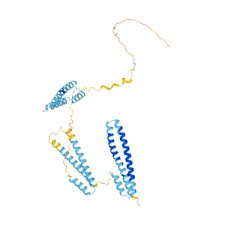What is LRPAP1 Protein
The LRPAP1 protein, also known as Low-Density Lipoprotein Receptor-Related Protein Associated Protein 1 or simply Lipoprotein Receptor-Related Protein 1, plays a significant role in the larger biochemical processes in the body.
The LRPAP1 protein initially entered the scientific world in the 1990s, recognized for its firm association with the Low-Density Lipoprotein Receptor (LDLR) family. Since then, extensive investigations have continued to unravel its multifaceted role in the human body. Its gene, LRPAP1, is located on chromosome 4p16.3 in humans. The LRPAP1 protein has a beta-barrel structure, a trait that it shares with various proteins in the body. This unique shape allows for a tremendous variety of substances to be transported throughout the body.

Fig1. LRPAP1 Structure (GeneCards)
Function of LRPAP1 protein
The primary function of the LRPAP1 protein is to work in conjunction with the Low-Density Lipoprotein Receptor-Related Protein 1 (LRP1) and the LRP1B, controlling the normal circulation and uptake of LDL cholesterol. It functions as a chaperone protein that prevents the premature interaction of ligands with lipoprotein receptors during protein synthesis in the endoplasmic reticulum. As such, its responsibility is not limited solely to LDL cholesterol, but it can influence various ligands such as apolipoprotein E and lipoprotein lipase.
LRPAP1 protein related signal pathway
LRPAP1 protein plays a role in several signal pathways, the most significant of which is the regulation of the LDLR pathway. Although the complete mechanism of this pathway is still not fully understood, it is known that LRPAP1 negatively regulates LDLR's lipoprotein binding ability and modulates the degradation of LDLR. It acts as a molecular guard, patroling the LDLR functionalities and maintaining a consistent circulation of cholesterol and other lipids in the body.
LRPAP1 protein related diseases
Due to its pivotal role in lipid management, the LRPAP1 protein has been connected to various diseases, most notably cardiovascular diseases and certain forms of cancer. Malfunction or mutation in the LRPAP1 gene may lead to abnormal cholesterol balance, leading to atherosclerosis, myocardial infarctions, strokes, or other cardiovascular diseases. Additionally, because LRP1 is highly expressed in malignant cells associated with enhanced tumor growth and metastases, the loss of LRPAP1 function can exacerbate these conditions.
On the other hand, the presence or absence of LRPAP1 has been associated with certain neurological disorders. For instance, one study found a significant association between Alzheimer's disease and LRPAP1 polymorphism, suggesting the protein's likely involvement in the pathogenesis of the disease.
LRPAP1 protein's applications in biomedical
Despite these potential concerns, the LRPAP1 protein's unique traits offer a variety of possibilities in biomedical science. For example, the LRPAP1 protein's manipulation could provide novel insights into cholesterol regulation, which could then lead to innovative treatment strategies for cardiovascular diseases. The study of LRPAP1 can also provide valuable information about cell transport processes or a better understanding of Alzheimer's disease pathogenesis.
Moreover, LRPAP1 offers potential therapeutic advantages in cancer therapy, given its critical role in regulating LRP1, which is often found in high concentrations in cancer cells. A better understanding of the interactions and pathways involving LRPAP1 could lead to the development of drugs that could better target and kill cancer cells.
In conclusion, the LRPAP1 protein, though not as well-known as other proteins, plays integral roles in some of the body's most crucial pathways. Its management of LDL cholesterol, involvement in various diseases, and potential use in biomedical application is instrumental and continually being explored. Through ongoing research into LRPAP1, scientists are gradually unlocking its potential, promising advancements in the understanding, diagnosis, and treatment of various diseases. Thus, the future of LRPAP1 in the realm of biomedical science offers a promising avenue that is yet to be fully explored.
Our Featured Products
| Cat.No. | Product Name | Species | Source (Host) | Tag |
|---|---|---|---|---|
| LRPAP1-75H | Recombinant Human RAP, FITC Labeled | Human | E.coli | N/A |
| LRPAP1-2264H | Active Recombinant Human LRPAP1 protein, His-tagged | Human | HEK293 | His |
| LRPAP1-848H | Recombinant Human LRPAP1 Protein, MYC/DDK-tagged | Human | HEK293 | Myc/DDK |
| LRPAP1-6026HF | Recombinant Full Length Human LRPAP1 Protein, GST-tagged | Human | In Vitro Cell Free System | GST |
| Lrpap1-3359M | Recombinant Mouse Lrpap1, His tagged | Mouse | Human Cell | His |
| Lrpap1-5912M | Recombinant Mouse Lrpap1 protein, GFP-His-tagged | Mouse | HEK293 | GFP-His |
| Lrpap1-5913M | Recombinant Mouse Lrpap1 protein, His&Myc-tagged | Mouse | HEK293 | His&Myc |

